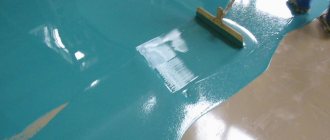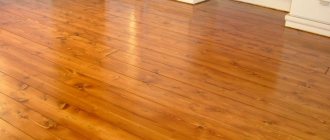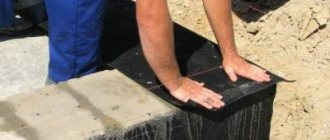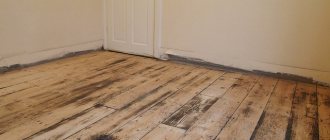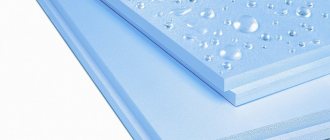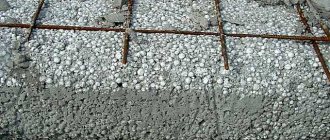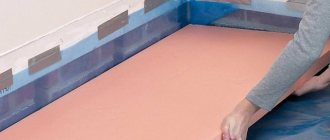The finishing floor covering is installed on a carefully prepared base. A leveling screed is laid on top of the floor slab, which after drying forms a smooth surface. However, the material shrinks, which significantly affects the quality of preparation. The curvature of the rough structure is compensated by the installation of a special material - a self-leveling self-leveling floor, the thickness of which is regulated by regulatory requirements and the manufacturer.
Self-leveling floor in the room
What is the essence of reinforcement?
The self-leveling coating itself - cement or polymer - does not need reinforcement, because it is already strong. But it cannot be applied to any base. The surface will have to be prepared first. It is precisely in the layers of the rough or preparatory base that the reinforcing material is laid.
Laying beacons for pouring the mixture
Bookmarking beacons
Important! The explanation for why the layers under a naive floor are reinforced is simple - if the base coating is strong, then the top layer will last longer, it will not have to hold the poorly set mixture in the lower layers.
Reinforcement is performed using metal mesh or fiber-fiber materials, which are added to the concrete during mixing.
Structure of reinforced screed
Sequencing
To increase the service life of the floor, it is necessary to carry out reinforcement work correctly. For convenience, professionals have divided the filling technology into several stages. Let us analyze in detail the algorithm of actions when reinforcing the base.
Surface marking
Before you start creating the screed, you need to correctly mark the floor. The procedure is easier to carry out using a laser level, although a hydraulic level can also be used. The equipment is placed on a flat surface and the beam is projected onto the wall.
Working with a laser level Source kraski-net.ru
After making the marks, draw a horizontal line. The distance from the floor is measured from the element, calculating the minimum. The found point is the zero marking, from which the thickness of the screed is determined. The parameter depends on the required strength of the base. The characteristic varies between 2.5-8 cm. In residential premises, the data must be the same in all rooms except the bathroom and loggia (balcony).
Preparatory work
Reinforcement of concrete floors is carried out on cleaned surfaces. The old screed is removed from the base, the remaining debris is taken out, and the dust is removed with a construction vacuum cleaner. The space around the perimeter is primed with a roller or paint brush. If the area is not treated, the cement will draw liquid out of the solution. Due to a violation of the technology, hardening occurs unevenly, which will lead to the appearance of cracks.
Removing debris before reinforcement Source stroisovety.org
When you can’t do without strengthening
There are a number of cases when concrete needs to be strengthened, but first it is worth considering the main tasks of reinforcement:
- Protection against microcracks. Any floor looks unaesthetic if cracks appear on it, self-leveling is no exception.
- Protection against the appearance and expansion of coating defects when exposed to vibration.
- Strengthening the base.
- Protection against screed subsidence.
- Increasing the service life of the floor.
The mixture will be strengthened by a polypropylene mesh.
Reinforcement will be required in such cases. Mandatory in such cases:
- If the base is unstable, floating. This applies to laminated floors that use sound insulation. In fact, such a floor is not attached to the base; it has the ability to “float” minimally.
- In any case, when installing heavy structures: stoves, fireplaces, machine tools and mechanisms.
- If the thickness of the layer that is mounted on the floor is more than 5 cm.
Grid element
Both base and finish
Self-leveling floor is a type of screed that forms a monolithic, seamless coating on the surface, the creation of which uses self-leveling (self-leveling) mixtures. According to its purpose, it is divided into two categories - leveling base and finishing decorative coating.
Leveler
Available in the form of dry mixtures mixed with water. The presence of fine-grained fillers (up to 250 microns), mineral binders and modifiers in the composition ensures plasticity and uniformity of the solution. Depending on the manufacturer and scope of application, sub-level self-leveling floors may have a cement or gypsum base.
After hardening, a strong, wear-resistant, smooth, even surface is formed, designed for subsequent cladding.
Unlike cement-sand screed, the result is an elastic coating that is not subject to cracking and shrinkage. In addition, bulk leveling mixtures gain brand strength faster - on average, in 15 days. There are also special compositions that harden within a few hours.
The thickness of the poured layer depends on the parameters of the base, the lower limit is 5 mm. Some brands can be filled with a layer of up to 60 mm. Leveling mixtures are used as a rough coating for facing laminate, linoleum, tiles, parquet, decorative self-leveling flooring and others that require a perfectly flat base. The difference allowed according to SNiP is 2 mm/m², and levelers allow you to quickly and efficiently prepare the base.
The mixture is selected based not only on the data of the base for pouring and the required thickness, but also on the compressive strength of the screed, since different cladding requires different strengths. For example, almost any self-leveling floor is suitable for a laminate, and the most durable one is suitable for a decorative self-leveling floor based on epoxy. For technical rooms where finishing is not always carried out, it is worth using industrial-grade “fillers” with a strength of 35 MPa or more, our forum members are aware of this.
Palych R34 FORUMHOUSE Member
For laminate flooring, a floor strength of 8-10 MPa is sufficient; almost any self-leveling material will do. And for epoxy you need a strength of 25 MPa. Here only high-strength bulk liquids can cope.
Finishing
Decorative self-leveling floors have all the advantages of levelers - they provide a strong, durable, wear-resistant and perfectly smooth coating. But at the same time, in addition to an impressive set of characteristics, they also have an attractive appearance - imitation marble, ornate patterns, combinations of contrasting tones, fancy multi-colored mixes, seabed, with a three-dimensional effect (3D) and many others.
Although polymer-cement floors, intended for leveling the base for finishing, are sometimes used as a finishing coating, special decorative self-leveling mixtures are polymer, which greatly expands the possibilities of decoration. The composition of polymer floors is one-component or two-component, based on polyurethane or epoxy resin, with modifying additives. Both levelers and finishing self-leveling floors tolerate temperature changes and heating well, so they can be used in a heated floor system. But the maximum temperature of the compositions is different; when choosing, you should pay attention to this indicator.
The thickness of the poured layer varies from 1 to 8 mm, so to create decor you can use not only flat, but also convex elements - coins, shells, pebbles.
“Nivaikas” are especially relevant in high-traffic areas, technical rooms, bathrooms and kitchens. However, a decorative coating with a three-dimensional effect can decorate a living room, a bedroom, or a children's room, whether it is branded or homemade. Self-leveling floor 3D is a multi-layer coating, including:
- base layer – prepared base;
- the decorative coating itself - a three-dimensional photograph on special paper or fabric, homemade posters, pictures, drawings, fabric, small decorations and the like;
- finishing layer – transparent polymer;
- protective layer - varnish.
A self-leveling floor with a three-dimensional effect is an expensive pleasure, even if you install it yourself, and if you hire professionals, the price doubles. Simpler polymer floors, plain, imitating marble or with colored “blots”, will cost less, but still not the most affordable material. However, the decorativeness of the coating and its durability, subject to the technological process, compensate for the costs.
Layer structure
To understand at what stage the reinforcement is carried out, it is worth disassembling the structure of the floor on the ground, as the most complex structure:
- Compacted soil.
- Rough pouring of concrete. It is not reinforced; cement and sand diluted with water are used for filling.
- Vapor barrier - this layer is required, otherwise the insulation will suffer from negative influences, and this will affect its quality.
- Concrete screed with reinforcement; at this stage, fiberglass is added to the composition or a reinforcing mesh is embedded inside. It is important that it is placed in the middle of the concrete mixture layer.
- After drying, any self-leveling floor - cement or polymer - is poured on top.
Classification of self-leveling coatings
All floors differ in their composition and purpose:
- Methyl methacrylate is a quick-drying option; when working with it, the room should be well ventilated. Protective equipment will not be superfluous. There is no smell left after drying. It is possible to use various additives.
- Acrylic-cement is the cheapest flooring option, but has good moisture resistance. An excellent option for bathrooms, saunas, car washes. Does not require preliminary surface preparation, and the layer thickness can reach 25-30 cm.
- Polyurethane - characterized by high mechanical strength, therefore it is most often used in office, warehouse and industrial premises. The price of such a floor is high, but it pays off with its long service life. A wide selection of colors that do not fade in the sun and do not fade.
- Epoxy flooring is impervious to chemicals, aggressive liquids, acids, and oils; it is durable and does not collect dust on its surface. Can be used in medical and educational institutions, garages.
- Epoxy-urethane - the highest degree of wear resistance. It is used in crowded places, vestibules, passage areas and platforms.
In addition to differences in composition, the floor surface may differ in the following characteristics: matte, semi-matte, glossy, semi-gloss.
Attention! Separately, it is worth noting the screeds for leveling and rough finishing. They are necessary to level out significant differences in height. Cement mortar with the addition of plasticizers or a gypsum mixture can be used.
What can strengthen the screed
The screed will be strengthened only if certain materials are used to lay it in its layers. Materials used:
- Metal mesh, if you can get any road mesh, this will be an excellent option.
- Polymer - it is made of plastic.
- Fiberglass mesh.
- Fiber is not a mesh, but fibers of polypropylene, glass, metal, basalt, which are poured into the composition when kneading. In the screed they are securely held together, thereby providing reinforcement throughout the entire thickness of the coating.
Fiber fiber can be mixed into the mixture
Reinforcement order
In order for any mixture to become durable, it is important to carry out the process correctly and compose the layers of the floor “pie” in the required order. First of all, prepare the rough coating - it is cleaned of dust and dirt. In order for the concrete layer to be firmly bonded to the base, it is important to cover it with a primer.
Pouring the mixture onto the reinforcing mesh
Next, fix the beacons on the plane, preferably metal ones; they should be placed approximately in the middle of the future layer. Reinforcing mesh will be laid on them. Next, the selected reinforcing material is fixed and concrete is poured. It is important that the mixture penetrates all areas of the floor, that is, it completely fills the mesh.
After this, wait 30 minutes and rub the surface until the coating is completely even. When the concrete has completely hardened, and this will happen after 30 days, you can install the self-leveling floor.
Cases of using polypropylene mesh for reinforcing concrete mixtures
Optimal layer
Despite the high cost of self-leveling polymer floors, they require a minimum thickness. Optimal compositions sometimes reach only a few millimeters, such as polyurethane compositions. On top of this you can even apply the composition together with colorant, with a thickness of no more than 0.3 mm. Even adding shine and beauty to the surface does not take up much space on the entire surface.
Layers of self-leveling floor
No one makes such floors larger than five millimeters, since all the characteristics still remain at the same level. Only money goes down the drain. Such thickness parameters are also typical for epoxy compounds. However, if you want to paint such a surface, then the layer should be large due to the high fragility of the epoxy.
Methyl methacrylate compounds dry quickly and can be applied in a layer of 1 mm. This height will be sufficient for minimal loads. When the mixture is based on cement, the optimal layer will be 8 mm.
